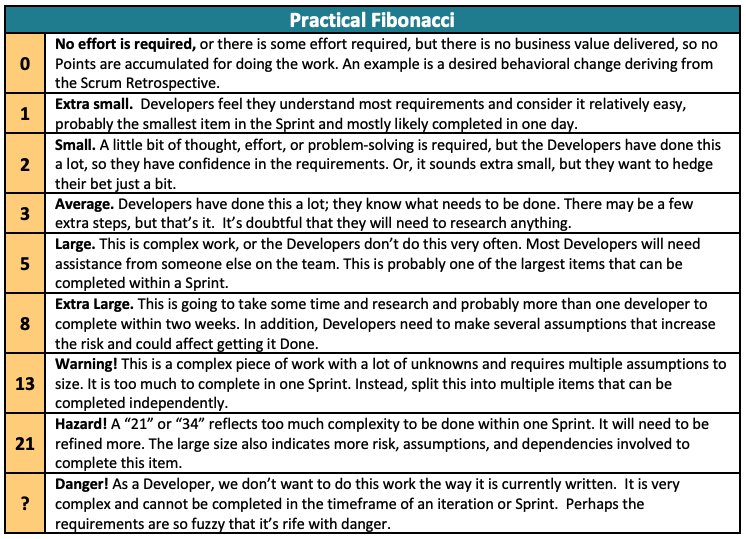Practical Fibonacci is a lightweight, confidence-based approach to job sizing. By using Fibonacci numbers to estimate effort, teams can express not just how long something might take — but how much clarity, confidence, and complexity is involved. This method encourages meaningful conversation about risk, unknowns, and deliverability, helping teams avoid underestimating large or unclear work, and ensuring that effort leads to real business value.

No Effort Required
or there is some effort required, but there is no business value delivered, so no points are accumulated for doing the work. An example is a desired behavioural change deriving from a Scrum Retrospective
Extra small
Developer feels they understand most requirements and consider it relatively easy, probably the smallest item in the Sprint and is most likely completed in one day.
Small
A little bit of thought, effort or problem solving is required, but the Developer have done this a lot. so they have confidence in the requirements. or it sounds extra small, but they want to hedge their bet a bit
Average
Developer has done this a lot, they know what needs to be done. There may be a few extra steps, but that’s it. It’s doubtful they will need to research anything
Large
This is complex work, or the Developer does not do this often, Most Developers will need assistance from someone else on the team. In addition, the developer needs to make several assumptions that increase the risk and could affect getting it Done.
Extra Large
This is going to take some time and research and probably more than one developer to complete within two weeks. In addition, Developers need to make several assumptions that increase the risk and could affect getting it Done
Warning!
This is a complex piece of work with a lot of unknowns and requires multiple assumptions to size. It is too much to complete in one Sprint. Instead, split this into multiple items that can be completed independently
Hazard!
A 21 or 34 reflects too much complexity to be done in one Sprint, it will need to be refined more. The large size also indicates more risk, assumptions and dependencies involved to complete this item.
Danger!
As a Developer, we don’t want to do this work the way it is currently written. It is very complex and cannot be completed in the time-frame of an iteration or Sprint. Perhaps the requirements are so fuzzy that it is rife with danger.
